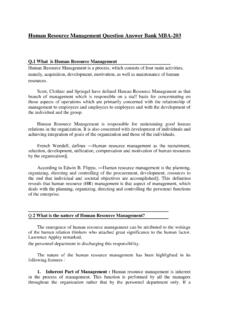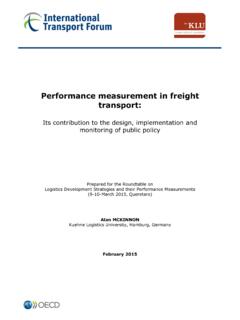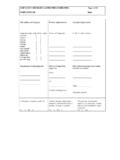Transcription of WAREHOUSING EFFICIENCY AND EFFECTIVENESS IN THE …
1 WAREHOUSING EFFICIENCY AND EFFECTIVENESS . IN THE LOGISTICS MANAGEMENT PROCESS. Gursharan Kaur Lecturer, Gobindgarh Public College, Alour, Khanna Dr N K Batra Principal, University College, Meeranpur, Punjabi University Abstract WAREHOUSING plays a significant role in the overall Logistics Management process. This paper focuses on back to the basics that are fundamental for warehouses to achieve both EFFICIENCY and EFFECTIVENESS in logistics management process. An attempt has been made to study thewarehousing network strategies and the loading and unloading methods adopted for material handling purposes in the warehouses. Key Words : WAREHOUSING , Logistics Management, EFFICIENCY , EFFECTIVENESS . Introduction In today's highly competitive global marketplace, the pressure on organizations to find new ways to create value and deliver it to their customers grows ever stronger. The increasing need for industry to compete with its products in a global market across cost, quality and service dimensions has given rise to the need to develop more efficient WAREHOUSING strategies.
2 WAREHOUSING has come to be recognized as a distinct function with the rise of mass production systems. WAREHOUSING is the storage of goods, whereas distribution center precedes a post-production warehouse for finished goods held for distribution. Therefore, WAREHOUSING and distribution centres basically have the same function of goods and products storage (Coyle at el, 2003). The warehouse and distribution centres are very important nodes in a supply chain network. They perform valuable functions that support the movement of materials, storing goods, processing products, de-aggregating vehicle loads, creating stock keeping unit assortments and assembling shipments (Andre Langevin and Riopel Diana, 2005). The efficient management of warehouses helps to optimise the existing production and distribution processes and greatly assist in the goal of cost reduction and service enhancement. In today's competitive environment, companies must operate at maximum EFFICIENCY and provide superior service to ensure profitability.
3 Three factors has been found to affect EFFICIENCY and EFFECTIVENESS of the warehouse operations with respect to fast moving consumer goods industry such as simplicity/complexity of the warehouse management systems, product slotting techniques and layout planning of the warehouse (Lakmal AGDP and Wickramarachchi WADN, 2011). The organizations ability to effectively manage the warehouse, reduce costs and fulfillment operations is critical to their success. It is pertinent to mention that the organizations face great challenges in managing warehouses. The role and importance of warehouses in American economy has been altered to great extent due to changes in the way of raw materials, intermediate goods, and finished products (John and Bowen, 2008). In the current scenario when customer satisfaction and service have become a prime reason for a business to stand apart from its competition, the need for effective warehouse management is largely seen more as a necessity.
4 Thus, the warehouse operating system must be designed for receiving inventory, timely order fulfillment to automated validation of warehouse activities and accurate inventory control to achieve peak performance across the entire enterprise. WAREHOUSING network plays a major role in the success of the physical distribution of products. It is observed that the leading firms adopt and implement the different WAREHOUSING strategies such as capacity switching, hub networking, cobbling and outsourcing (Sople , 2010). Both the analytic and simulation models are proposed for improving warehouse design practices. Analytic models are usually design-oriented, explore many alternatives quickly to find solutions. On the other hand, simulation models are usually analysis oriented. They provide an assessment of a given design, but usually have limited capability for exploring the design space. There is an important need to integrate both approaches to achieve more flexibility in analyzing warehouse problems (Gu Jinxiang, 2010).
5 Besides the new trends in supply chains, technology development also has a large impact on WAREHOUSING . Many operations which used to be done manually have now been mechanized or even automated. In an automated warehouse, robots might be used to stack incoming products on pallets. The content of each pallet is communicated to the central computer which assigns the pallet to an empty location in the storage area. Conveyors or Guided Vehicles are used to transport the incoming pallets to the storage buffer and automated Storage/Retrieval machines are used to store the pallet at the right position in the storage area (Yu Mengfei, 2008). Objectives of Study The main objectives of the study are- 1. To study the objectives of efficient WAREHOUSING operations with respect to companies under study. 2. To study the WAREHOUSING network strategies followed in organisations under study. 3. To analyse the loading and unloading methods adopted for material handling purposes in the warehouses of companies under study.
6 Research Methodology The purpose of the research is to study the objectives of efficient WAREHOUSING operations and warehouse network strategies adopted by the organizations under study. The primary and secondary data has been collected for the purpose of study. The primary data has been collected with the help of structured questionnaire and conducting interviews with employees of concerned department of companies under study. The secondary data has been collected from the records available with manufacturing units, corporate offices, annual reports, monthly an d annual plan charts, magazines, research journals, publications, studies and articles. The sample of the study includes 84 respondents from the bicycle manufacturing companies operating in Punjab. The respondents include the managers and supervisors work ing in ten different complete bicycle manufacturing organizations- two of which belong to organized sector and the rest of organisations belong to unorganized sector.
7 The manufacturing houses included in the study are Hero cycles Limited, Avon Cycles Limited, Seth Industrial Corporation, S. K Bike Pvt. Ltd, Eastman Industries Limited, Kohinoor Cycle Pvt. Ltd, Jindal Fine Industries, Ravi Industries, Vishal Cycles Pvt. Ltd and Partap Engineers. The basis for choosing Punjab for carrying out research is due t o concentration of more bicycle manufacturing organisations' in the state and large quantity of production of bicycles in the state. Ludhiana is hub for bicycle manufacturing in India, producing more than 40000 cycles per day. Data Analysis In order to fulfill the objective of the study, both theoretical and empirical studies are conducted. The empirical study is implemented by interviewing warehouse managers/supervisors of different organizations with the help of a questionnaire. The data has been analyzed using statistical techniques like percentage, mean and ANOVA. TABLE 1: ANALYSIS OF OBJECTIVES FOR EFFICIENT WAREHOUSING OPERATIONS.
8 S. No. Methods Mean Std. One way ANOVA. Deviation F Sig 1. Providing timely Between Groups customer service Within Groups 2. Keeping track of items Between Groups Within Groups 3. Lower operating costs Between Groups Within Groups 4. Providing Between Groups communication links Within Groups with customers 5. Higher Inventory Between Groups turnover Within Groups A warehouse acts as a supporting function for logistics and plays a key role in attaining the overall objectives of the firm's logistical supply chain system. The table 1 presents the analysis of objectives of efficient WAREHOUSING operations achieved in the organizations under study. The analysis indicates that providing timely customer service is given priority (avg. mean ) followed by keeping track of items (avg. mean ) and higher inventory turnover (avg. mean ). Providing communication links with the customers (avg. mean ) and lower operating costs (avg. mean ). Further, the analysis of variance indicates that F value is significantp(<.)
9 05) for low operating costs ( ), Providing communication links with the customers ( ) and higher inventory turnover ( ) implying that means are significantly different from one another. While for providing timely customer service (F ) and keeping track of items (F ) F value is not significant indicating that means remains same. TABLE 2: WAREHOUSING STRATEGIES FOLLOWED IN ORGANISATIONS. S. WAREHOUSING Strategies Frequency (N) Percentage (%). No. 1. Capacity Planned on basis of Average demand 84 100. 2. WAREHOUSING hubs planned at few strategic locations 0 0. 3. Sharing of warehouses with non competitors to reduce cost 0 0. 4. Outsourcing 0 0. Total 84 100. WAREHOUSING network plays a major role in the success of the physical distribution of products. In the scenario of growing competition and to meet the customer expectations for cost and service, the organization implement various WAREHOUSING strategies. The table 2 indicates the analysis of WAREHOUSING strategies followed in bicycle organizations under study.
10 The data depicts that capacity switching WAREHOUSING strategy is adopted by the bicycle manufacturing organizations under study, in which capacity is planned on the basis of average demand. TABLE 3: LOADING AND UNLOADING METHODS ADOPTED IN WAREHOUSES. S. No. Loading and Unloading Methods Frequency (N) Percentage (%). 1. Fork Lift 0 0. 2. Manual 62 3. Conveyer belt 0 0. 4. Mini crane 0 0. 5. Counter balanced truck 0 0. 6. Electric Bike 0 0. 7. Manual and Conveyer belt 12 8. Manual and Conveyer belt and Electric bike 10 Total 84 100. The productive potential in logistics can be exploited by selecting right type of handling equipment. For moving in and out of warehouse, various kinds of equipment and systems are used depending on the type of products. The table 3 presents the analysis of loading and unloading methods used in the warehouses for handling purposes. The analysis indicates that of respondents state that manual methods are used for loading and unloading of goods in the warehouses, whereas respondents opined that conveyer belts are used along with the manual methods for loading and unloading purposes.












